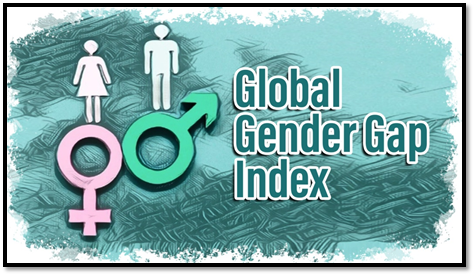BRIDGING GENDER GULF IN THE SPHERE OF ECONOMY
Syllabus:
- GS-3- economic development , gender analysis , equality in all fields, ethical perspective
Focus :
- The article focuses on the persistent gender gap in the economy, examining its historical roots, current state, and economic benefits of gender equality. It outlines strategies to bridge this gap, including policy interventions, education, financial inclusion, and workplace practices, while highlighting challenges and successful case studies that demonstrate the potential for inclusive growth.
Source - IE
Introduction
- The gender gap in the economy refers to the disparity between men and women in terms of economic participation, opportunities, income, and advancement.
- Bridging this gap is crucial for fostering inclusive growth, enhancing productivity, and ensuring sustainable development.
- Despite progress in many areas, significant gender disparities remain in labor force participation, wages, leadership positions, and access to resources.
Historical Context
- Historically, economic roles were divided along gender lines, with men dominating public and economic spheres while women were often relegated to domestic roles.
- Industrialization and wars in the 20th century saw more women entering the workforce, yet the structures and policies remained largely patriarchal.
- Feminist movements have been pivotal in challenging and changing these dynamics, advocating for equal rights, pay, and opportunities.
Current State of the Gender Gap in the Economy
Labor Force Participation
- Women’s participation in the labor force has increased globally but still lags behind men.
- Societal norms and caregiving responsibilities significantly impact women’s ability to work.
- In many regions, legal and cultural barriers prevent women from fully participating in the economy.
Wage Gap
- Women, on average, earn less than men for similar work, a phenomenon known as the gender pay gap.
- Factors contributing to this include occupational segregation, differences in work experience, and discrimination.
- The pay gap is wider for women of color and women with disabilities.
Leadership and Representation
- Women are underrepresented in leadership positions across various sectors, including business, politics, and academia.
- Gender stereotypes and biases often hinder women’s advancement to senior roles.
- Initiatives like quotas and diversity policies are being implemented to improve representation.
Access to Resources and Opportunities
- Women face barriers in accessing education, financial services, and land ownership, which limits their economic opportunities.
- Gender-based violence and harassment in workplaces further restrict women’s participation.
- Supporting women’s entrepreneurship through targeted programs and funding can help bridge this gap.
Economic Benefits of Gender Equality
- Closing the gender gap could significantly boost global GDP and economic growth.
- Gender diversity in leadership and decision-making roles leads to better performance and innovation.
- Equal participation of women in the economy contributes to poverty reduction and improved family welfare.
Strategies to Bridge the Gender Gap
Policy Interventions
- Implementing laws and regulations that promote gender equality in the workplace.
- Ensuring equal pay for equal work and transparency in pay structures.
- Providing parental leave and affordable childcare to support working parents.
Education and Skill Development
- Encouraging girls and women to pursue education and careers in STEM (Science, Technology, Engineering, Mathematics) fields.
- Offering vocational training and skill development programs targeted at women.
- Promoting mentorship and sponsorship programs to support women’s career growth.
Financial Inclusion
- Improving women’s access to financial services, including credit, savings, and insurance.
- Supporting women entrepreneurs through grants, low-interest loans, and business development services.
- Addressing legal and cultural barriers to women’s ownership of property and assets.
Workplace Culture and Practices
- Creating inclusive workplaces that support diversity and prevent discrimination and harassment.
- Implementing flexible work arrangements and family-friendly policies.
- Promoting gender-sensitive recruitment, retention, and promotion practices.
Advocacy and Awareness
- Raising awareness about the economic benefits of gender equality among policymakers, businesses, and the public.
- Encouraging men to participate in gender equality efforts, including shared caregiving responsibilities.
- Supporting organizations and movements that advocate for women’s economic rights and empowerment.
Challenges and Barriers
- Deep-seated cultural norms and stereotypes that perpetuate gender inequality.
- Resistance to change within institutions and industries.
- Limited enforcement of gender equality laws and policies.
- The impact of the COVID-19 pandemic, which has exacerbated existing inequalities.
Case Studies and Success Stories
Rwanda
- Rwanda has made significant strides in gender equality, particularly in political representation, with women holding a majority in parliament.
- Policies supporting women’s education and economic participation have been crucial to these achievements.
Nordic Countries
- Nordic countries consistently rank high in gender equality indices due to robust social policies, including parental leave and childcare support.
- These countries demonstrate the economic benefits of gender-balanced leadership and workforce participation.
Corporate Initiatives
- Companies like Google, IBM, and Accenture have implemented successful diversity and inclusion programs, resulting in better gender balance and improved business performance.
- Corporate gender equality awards and rankings incentivize companies to adopt inclusive practices.
Conclusion
- Bridging the gender gulf in the economy is not only a matter of social justice but also an economic imperative.
- Governments, businesses, and civil society must collaborate to create an environment where both men and women can equally contribute to and benefit from economic growth.
- Sustained efforts in policy-making, education, financial inclusion, and cultural change are essential to achieve gender equality in the economic sphere.
- The future of the global economy depends on the full and equal participation of all its members, regardless of gender.
Mains UPSC Question
“Discuss the persistent gender gap in the economic sphere, highlighting its historical roots and current state. Examine the economic benefits of bridging this gap and outline effective strategies for achieving gender equality in the workforce. Illustrate your answer with relevant case studies and examples of successful initiatives.”(250 words)
Associated Article –
https://universalinstitutions.com/giving-primacy-to-human-development/




